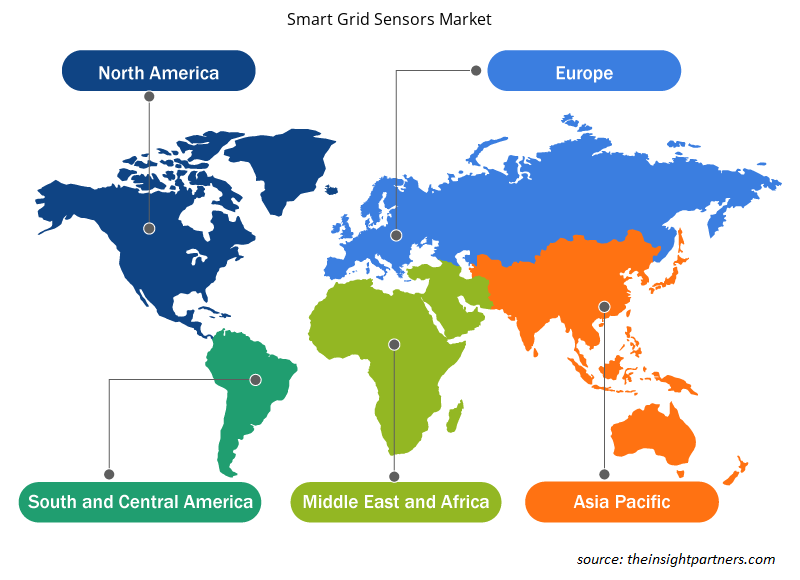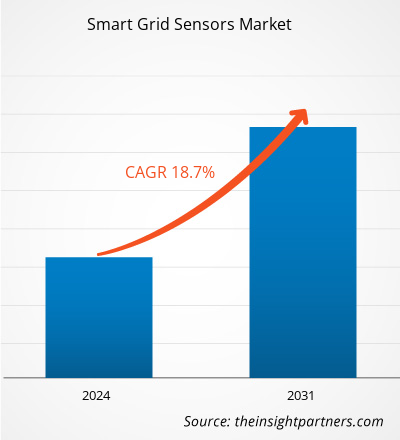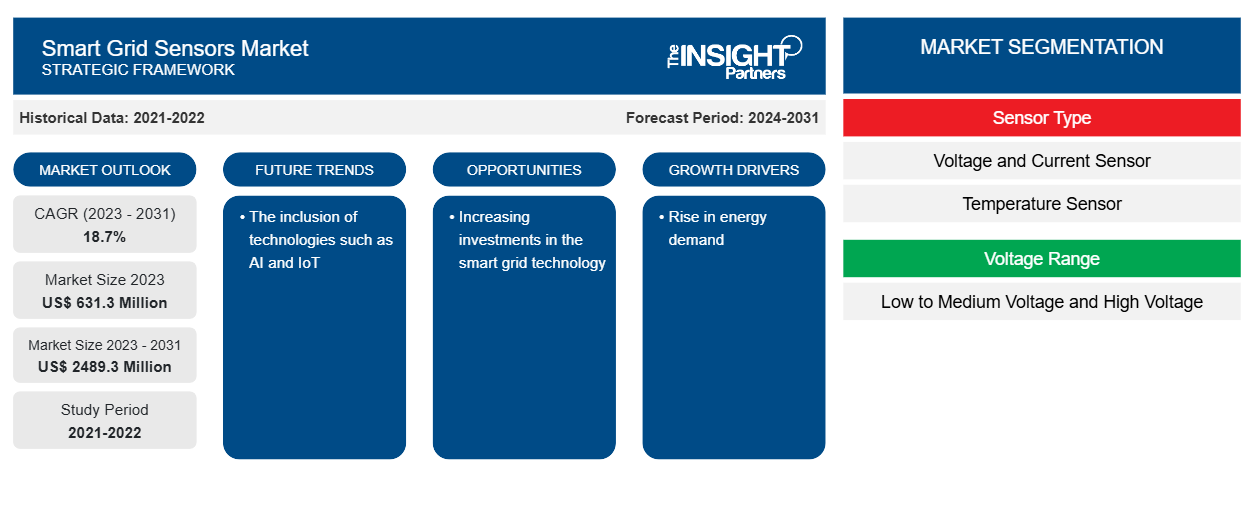智能电网传感器市场规模预计将从 2023 年的 6.313 亿美元增至 2031 年的 24.893 亿美元。预计 2023-2031 年市场复合年增长率将达到 18.7%。能源和电力行业的进步以及政府对智能电网技术的投资可能仍是智能电网传感器市场的主要趋势。
智能电网传感器市场分析
由于智能城市项目不断增加,智能电网的安装也推动了智能电网传感器市场的成长。此外,智能电网取代传统电网的现象日益增多,也刺激了对智能电网传感器的需求。全球需要高效的能源生产、分配和电力传输,这导致人们采用更智能的解决方案。这将导致人们采用智能电网技术,从而为智能电网传感器市场的增长创造机会。
智能电网传感器市场概况
智能电网是利用信息、先进网络和实时监控和控制技术来降低成本、节约能源并提高安全性、互操作性和可靠性的电网。这些智能电网中使用的传感器可实时提供电网数据和状态,从而实现实时监控、保护和控制。这些传感器用于测量各种参数,包括温度、电压、电流和功耗。这些传感器使用高级分析和机器学习 (ML) 算法来检测数据中的模式和异常,这可以帮助公用事业公司识别和预防设备故障和停电等问题。
定制此报告以满足您的需求
您可以免费定制任何报告,包括本报告的部分内容、国家级分析、Excel 数据包,以及为初创企业和大学提供优惠和折扣
-
获取此报告的关键市场趋势。这个免费样品将包括数据分析,从市场趋势到估计和预测。
智能电网传感器市场驱动因素和机遇
能源需求上升利好市场
城市化、生活水平提高、可支配收入增加以及先进技术的采用正在推动能源需求。随着全球住宅和商业部门对电力的需求增加,电网变得越来越复杂。随着电网变得越来越复杂,可持续、可靠、高效和安全的电力分配和生产变得越来越重要。随着电力消耗和需求的增加,生产和分配变得越来越困难。随着电网变得更加智能和应用越来越广泛,对智能电网传感器的需求也日益增长。
增加对智能电网技术的投资——智能电网传感器市场的机遇
全球范围内使用智能电网技术的倡议正在不断增加,以解决二氧化碳排放等环境问题。根据国际能源署 2022 年 9 月的数据,到 2030 年,智能电网的投资将翻一番,以实现 2050 年净零排放情景,主要集中在新兴市场和发展中经济体。因此,智能电网技术安装量的增长推动了对智能电网传感器的需求,以实现高效的工作环境。
智能电网传感器市场报告细分分析
有助于智能电网传感器市场分析的关键部分是传感器类型、电压范围和应用。
- 根据传感器类型,市场分为电压和电流传感器、温度传感器等。电压和电流传感器部分在 2023 年占据了较大的市场份额。
- 根据电压范围,市场分为低压至中压和高压。2023 年,低压至中压部分占据了最大的市场份额。
- 根据应用,市场分为变电站自动化、先进计量基础设施、智能电网配电网等。变电站自动化领域在 2023 年占据了最大的市场份额。
智能电网传感器市场份额按地区分析
智能电网传感器市场报告的地理范围主要分为五个区域:北美、亚太、欧洲、中东和非洲、南美/南美和中美。
就收入而言,北美在 2023 年占据了智能电网传感器最大的市场份额。与其他地区相比,该地区的技术先进,这是推动北美智能电网传感器市场份额的主要因素之一。
随着美国家庭和公司越来越多地使用电子设备和技术能力,公用事业公司对实时了解电力需求变化的需求也在增加。在这种情况下,整合智能电网可以帮助为所有电网客户提供更可靠的电力。为了满足这一需求,北美各国政府正在对智能电网进行各种投资。例如,2022 年 9 月,美国能源部 (DoE) 正在寻求对一项 105 亿美元智能电网和其他升级计划的意见,以加强该国的电网。这笔资金分为三部分,其中 25 亿美元用于电网弹性,30 亿美元用于智能电网,50 亿美元用于电网创新。因此,对智能电网基础设施的投资不断增加,导致北美智能电网传感器市场增长。
智能电网传感器市场区域洞察
Insight Partners 的分析师已详尽解释了预测期内影响智能电网传感器市场的区域趋势和因素。本节还讨论了北美、欧洲、亚太地区、中东和非洲以及南美和中美洲的智能电网传感器市场细分和地理位置。

- 获取智能电网传感器市场的区域特定数据
智能电网传感器市场报告范围
| 报告属性 | 细节 |
|---|---|
| 2023 年的市场规模 | 6.313亿美元 |
| 2031 年市场规模 | 24.893 亿美元 |
| 全球复合年增长率(2023 - 2031) | 18.7% |
| 史料 | 2021-2022 |
| 预测期 | 2024-2031 |
| 涵盖的领域 |
按传感器类型
|
| 覆盖地区和国家 |
北美
|
| 市场领导者和主要公司简介 |
|
智能电网传感器市场参与者密度:了解其对业务动态的影响
智能电网传感器市场正在快速增长,这得益于终端用户需求的不断增长,而这些需求又源于消费者偏好的不断变化、技术进步以及对产品优势的认识不断提高等因素。随着需求的增加,企业正在扩大其产品范围,进行创新以满足消费者的需求,并利用新兴趋势,从而进一步推动市场增长。
市场参与者密度是指在特定市场或行业内运营的企业或公司的分布情况。它表明在给定市场空间中,相对于其规模或总市场价值,有多少竞争对手(市场参与者)存在。
在智能电网传感器市场运营的主要公司有:
- ABB有限公司
- 莱姆
- 伊顿公司
- ltron 公司
- 卡姆斯特鲁普
- 兰迪斯+吉尔
免责声明:上面列出的公司没有按照任何特定顺序排列。

- 了解智能电网传感器市场主要参与者概况
智能电网传感器市场新闻和最新发展
智能电网传感器市场
通过收集一手和二手研究后的定性和定量数据进行评估,其中包括重要的公司出版物、协会数据和数据库。以下是市场发展情况的列表:
- 2021 年 2 月,TE Connectivity 推出了带电压传感器的 Raychem RSTI-VS 可分离连接器,可与 Kries 的电网监控设备 IKI-50 兼容,从而实现了智能电网应用。作为连接和传感器领域的全球领导者,TE Connectivity 推出了带电压传感器的 Raychem 智能 RSTI-VS 可分离连接器。它可用于 IEC 市场的电网监控和高级接地故障和短路检测。(来源:TE Connectivity, Inc,新闻稿,2021 年)
- 2023 年 3 月,NIST 研究人员 Eugene Song 和 Kang Lee 参加了 IEEE P2681 工作组,该工作组促成了一份技术报告 PES-TR102《中压智能电网传感器和传感器系统:测量精度和不确定性考虑因素》。该报告由 IEEE PES PSIM 传感器任务组 (TF) 赞助,并于 2023 年 1 月发布。该报告支持拟议的 IEEE P2681 标准“中压 (MV) 智能电网传感器和智能电子设备 (IED) 系统测试指南”的制定。(来源:美国国家标准与技术研究所 (NIST),新闻稿,2023 年)
智能电网传感器市场报告覆盖范围和交付成果
“智能电网传感器市场规模和预测(2023-2031)”报告对以下领域进行了详细的市场分析:
- 范围内所有主要细分市场的全球、区域和国家层面的市场规模和预测
- 市场动态,如驱动因素、限制因素和关键机遇
- 未来的主要趋势
- 详细的 PEST/波特五力分析和 SWOT 分析
- 全球和区域市场分析涵盖关键市场趋势、主要参与者、法规和最新市场发展
- 行业格局和竞争分析,涵盖市场集中度、热点图分析、知名参与者和最新发展
- 详细的公司简介
- 历史分析(2 年)、基准年、预测(7 年)及复合年增长率
- PEST和SWOT分析
- 市场规模、价值/数量 - 全球、区域、国家
- 行业和竞争格局
- Excel 数据集
近期报告
相关报告
客户评价
购买理由
- 明智的决策
- 了解市场动态
- 竞争分析
- 客户洞察
- 市场预测
- 风险规避
- 战略规划
- 投资论证
- 识别新兴市场
- 优化营销策略
- 提升运营效率
- 顺应监管趋势























 获取免费样品 - 智能电网传感器市场
获取免费样品 - 智能电网传感器市场